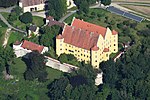Erbach an der Donau
Alb-Donau-KreisPopulated places on the DanubeTowns in Baden-WürttembergWürttemberg

Erbach an der Donau (Swabian German: Ärrbach) is a town on the Danube River in Baden-Württemberg, Germany. Located in the Alb-Donau District, Erbach lies between Ulm and Ehingen an der Donau on the southern edge of the Swabian Jura.
Excerpt from the Wikipedia article Erbach an der Donau (License: CC BY-SA 3.0, Authors, Images).Erbach an der Donau
Erlenbachstraße,
Geographical coordinates (GPS) Address Nearby Places Show on map
Geographical coordinates (GPS)
| Latitude | Longitude |
|---|---|
| N 48.328055555556 ° | E 9.8877777777778 ° |
Address
Erlenbachstraße 51/2
89155
Baden-Württemberg, Germany
Open on Google Maps







